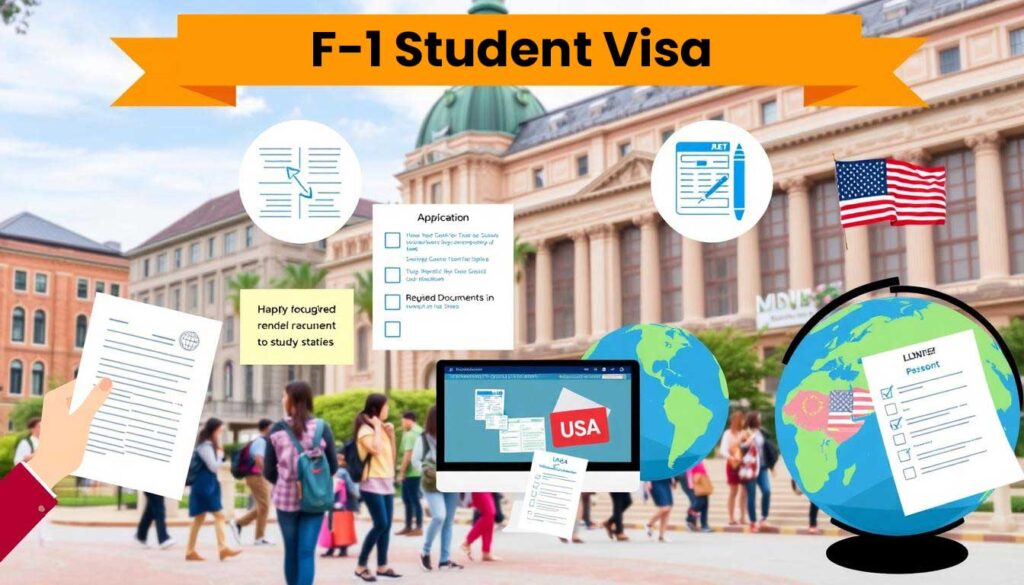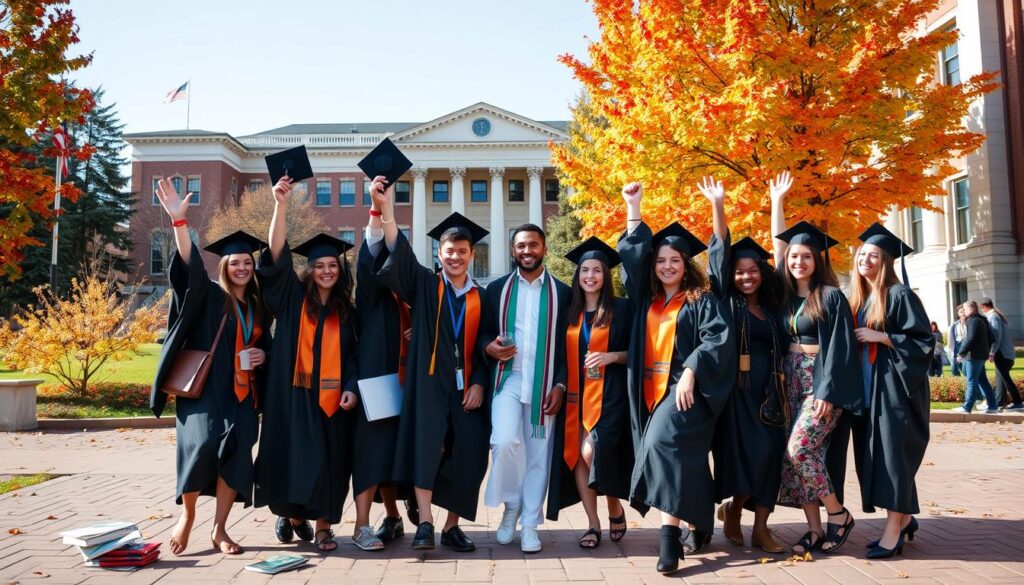Every year, over 1 million international students pick the USA for their graduate studies. Getting a master’s in the USA can change your career and education path. It offers top-notch learning in many fields.
Getting a master’s in the US means you get into cutting-edge research and programs. You can network globally. The US has everything from tech to business, arts to sciences, for your advanced learning and career.
This guide will cover all you need to know about getting a master’s in the US. It’s for international and domestic students looking for advanced education. We’ll explain the key steps, requirements, and tips for success in the USA.
Key Takeaways
- Over 1 million international students choose US universities annually
- Master’s programs typically last 1-2 years
- Diverse range of academic and professional degree options
- Robust research and innovation opportunities
- Potential for global career advancement
Why Choose the USA for Graduate Studies
Getting a Master’s degree in the United States is a big step. It opens doors to amazing educational chances. These chances change your academic and career paths in big ways.
Top universities in the USA are among the best worldwide. In the QS World University Ranking 2023, six of the top ten are in the United States. This shows how great American higher education is.
World-Class Educational Standards
US universities have high academic standards. They prepare students for global challenges. Students get access to the latest resources and teaching methods.
These help students think critically and develop practical skills.
Research and Innovation Opportunities
Graduate programs in the USA offer amazing research chances. Students can work on big projects and team up with top researchers. Many universities help students with funding and workshops.
Cultural Diversity and Networking
The USA has a diverse student population. In the 2021/22 academic year, over 943,000 international students studied here. This diversity helps students build global networks and learn to communicate across cultures.
Understanding the US Master’s Degree System
The US graduate education system is dynamic and wide-ranging. Every year, over 500,000 students get a master’s degree. These programs last from one to three years, giving deep knowledge and special skills.
Master’s degree programs in the US are both flexible and tough. Students take six to eight advanced courses. They also do a thesis or intensive study project. This mix of coursework and research prepares students for the job world.
| Degree Type | Typical Duration | Credit Requirements |
|---|---|---|
| Master of Arts (MA) | 1-2 years | 30-45 credits |
| Master of Science (MS) | 1.5-2 years | 30-60 credits |
| Professional Master’s | 1-3 years | 36-72 credits |
Accreditation is key in the US graduate education system. Schools are checked to make sure they offer quality education. The school year usually has semesters or quarters. Most programs offer full-time and part-time options for students.
Only 3% of Americans have a master’s degree. This makes it a big achievement. There are many types of master’s degrees, like MBA, MFA, and MSW.
Types of Master’s Programs Available
The United States has many master’s degree options for international students. They can pick from various fields to match their career dreams and interests.
Graduate education in the USA offers many paths for advanced learning. Knowing the different types of master’s programs helps students choose wisely.
Master of Arts (MA) Programs
MA programs focus on humanities, social sciences, and liberal arts. They teach critical thinking, research, and deep academic study. Students can study literature, history, psychology, communication, and more.
Master of Science (MS) Programs
MS programs are for science, technology, engineering, and math fields. They are common in areas like computer science, engineering, and biology. These programs include lots of research and lab work.
Professional Master’s Degrees
Professional master’s degrees are for specific careers. Examples are MBA, MPA, MEd, and MSW. They give students the skills needed for their future jobs.
| Degree Type | Focus Area | Typical Duration |
|---|---|---|
| MA | Humanities & Social Sciences | 1-2 years |
| MS | Scientific & Technical Fields | 1-3 years |
| Professional Degrees | Career-Specific Training | 1-3 years |
Each master’s program has its own benefits. This lets students pick the best path for their goals. The variety ensures international students can find the right fit for their dreams.
How to Do MS in USA
Getting a Master of Science (MS) in the United States needs careful planning. The application process has many important steps. These steps can greatly affect your academic path.
Start by researching universities. Look for schools that match your goals. With over 3,200 universities for international students, picking the right one is key.
Key Steps in the Graduate School Application Process
| Stage | Key Actions |
|---|---|
| 1. Program Research | Identify top universities, program specializations, faculty expertise |
| 2. Test Preparation | GMAT (600-740), GRE (318-329), TOEFL/IELTS scores |
| 3. Application Submission | Transcripts, recommendation letters, statement of purpose |
| 4. Financial Planning | Tuition ($20,000-$70,000), living expenses ($900-$1,500 monthly) |
Standardized tests are very important. International students need to show English skills with IELTS or TOEFL. They also need GMAT or GRE scores for programs.
Think about money too. MS programs cost between $20,000 and $70,000 a year. Scholarships like the Fulbright Foreign Student Program can help with costs.
Also, know about work chances. The F-1 visa lets you work up to 20 hours a week on campus. You can also get Optional Practical Training (OPT) after graduating. This gives you valuable work experience.
Admission Requirements and Prerequisites

Going to graduate school in the United States has its own rules. These rules can be tricky for students from other countries. Knowing these rules is key to getting into master’s programs at American universities.
Universities look for students with a solid academic record. They usually want a bachelor’s degree with a GPA of 3.0 or higher. Some schools might accept lower GPAs if you show great skills or take extra tests.
Academic Qualifications
What you need to get into a program varies. For example, Computer Science might need math and programming classes. Nursing programs want a Bachelor of Science in Nursing. Business programs are more open to different backgrounds.
Standardized Test Requirements
GRE scores are very important for getting into graduate school. About 85% of schools need GRE scores for master’s programs. Some schools might not need them if you have very good grades or work experience.
Language Proficiency
International students must show they can speak English well. They do this with TOEFL or IELTS tests. Most schools want scores between 80-100 on TOEFL or 6.5-7.0 on IELTS. This makes sure students can do well in school.
To apply successfully, you need to send in lots of documents. These include your academic records, test scores, letters of recommendation, and a personal statement. Your personal statement should show your goals and what you’ve achieved so far.
Application Process and Documentation
Getting into graduate school takes a lot of work and focus. Students aiming for a Master’s degree in the USA need to put together a detailed application. This package should show off their academic skills and career dreams.
The personal statement is key to standing out. It lets you share your special experiences, research interests, and career plans. This is how admissions teams get to know you and what drives you.
| Application Document | Key Requirements |
|---|---|
| Academic Transcripts | Certified copies from all previous institutions |
| Standardized Test Scores | GRE, TOEFL/IELTS (depending on program) |
| Letters of Recommendation | 2-3 from academic or professional references |
| Personal Statement | Tailored to specific program requirements |
International students have extra steps to take. Most universities need certified translations of non-English documents. Start your application 15 months before you want to start, with Fall applications opening in September.
Here are some tips for a strong application: • Start early • Check each university’s needs • Make sure all translations are certified • Send in a complete application
The application process has many steps, from preparing for tests to gathering documents. Students should plan enough time for this. They also need to work on their personal statement carefully.
Cost of Studying in the USA
Going to graduate school in the United States needs good planning. The cost of tuition varies a lot. It’s important to know all the expenses you’ll face.
Tuition Fees by Program Type
Graduate school tuition costs differ a lot. Public universities are often cheaper. In-state students pay about $10,740 a year.
International students at public schools pay between $25,000 and $35,000 yearly. Private schools cost more, with tuition from $30,000 to $70,000 a year.
Living Expenses
Living costs in the USA are key to think about, too. Students need to plan for $10,000 to $18,000 a year for living. This includes rent, food, and other daily needs.
Cities like New York have higher living costs. Rent there can be from $1,500 to $3,000 a month.
Additional Costs
There are extra costs like health insurance and textbooks. Planning your finances well can help with these extra costs. Scholarships and financial aid can help a lot, too.
| Expense Category | Annual Cost Range |
|---|---|
| Tuition (Public Universities) | $25,000 – $35,000 |
| Tuition (Private Universities) | $30,000 – $70,000 |
| Living Expenses | $10,000 – $18,000 |
| Health Insurance | $1,200 – $2,500 |
| Books and Materials | $900 – $2,000 |
Scholarships and Financial Aid Options
Looking for graduate scholarships in the USA needs careful planning and early action. International students face special challenges in finding financial help. About 65% of them rely on family money for school costs.
Grad students have many ways to get financial help. U.S. colleges offer some financial aid for graduate studies. Scholarships come in different types. They can be based on merit, need, or specific programs. These can greatly lower school costs.
Financial aid for international students often involves several steps. Private loans for international students are available, but they usually need a cosigner. F-1 visa holders can also get part-time jobs on campus. These jobs help with living costs.
Important financial aid stats show how complex funding for graduate studies is:
| Financial Aid Category | Amount |
|---|---|
| Average Federal Aid for Graduate Students | $28,300 |
| Maximum Federal Student Loan Limit | $138,500 |
| Graduate Students in Debt | 60% |
International students should look for scholarships from their home countries, university departments, and other groups. For example, the Saudi Arabian government gives full scholarships to many students in the USA.
Pro tip: Start scholarship applications early, keep your grades high, and look at many funding options to get the most help.
Student Visa Requirements and Process
Getting a US visa for international students can be tricky. The F-1 student visa is key for studying in the US. Every year, thousands of students get this visa to follow their dreams.

Students must prepare well for their F-1 visa journey. The process has many steps and needs careful attention.
F-1 Visa Application Steps
The F-1 visa process has important steps. First, students need an I-20 form from a US school. Getting an F-1 visa costs about $535, including a $350 SEVIS fee and a $185 DS-160 fee.
| Visa Application Requirement | Details |
|---|---|
| SEVIS Fee | $350 |
| DS-160 Application Fee | $185 |
| Total Visa Cost | $535 |
| Visa Validity | Can be issued up to 120 days before course start date |
Visa Interview Preparation
Preparing for the visa interview is key. Students need to bring lots of documents, like school records and financial proof. Visa interview wait times can vary by country and may take several months, so book early.
Maintaining Visa Status
F-1 visa holders must follow strict rules. They must study full-time and take a minimum number of courses. After graduating, they can work for up to 12 months with OPT. STEM graduates can work for two more years.
Knowing these rules helps students have a smooth time in the US. Start your visa application three months before you plan to travel.
Career Prospects and Job Market
Getting a master’s degree in the USA can lead to great jobs. People with a master’s degree make about $240 more per week than those with a bachelor’s. This means they earn about $12,500 more each year.
Jobs in tech, engineering, healthcare, and management are plentiful. For example, software developers make $109,020 on average. Medical experts like nurse anesthetists can earn up to $195,610 a year. Employers often look for those with advanced degrees, making a master’s a smart choice for your career.
OPT for international students is a great way to get work experience. It lets graduates work in the US for up to a year after they finish their degree. Those in STEM fields can work for three years, giving them more time to grow in their careers.
| Career Field | Median Salary | Job Growth |
|---|---|---|
| Software Development | $109,020 | High |
| Nurse Anesthesia | $195,610 | Moderate |
| Management Positions | Varies by Industry | Strong |
Networking is key when looking for a job. More than 50% of jobs are found through who you know. Use university career services, LinkedIn, and other networks to find jobs.
Plan your career well, use OPT, and take advantage of university resources. A master’s degree can be a strong start in the US job market.
Housing and Living in the USA
Finding student housing in the USA needs careful planning. International students have many choices. Each option has its own benefits and things to think about.
Many graduate students choose on-campus housing. Dorms usually have 2-3 students per room. They are close to school resources. First-year students like it because it helps them fit in quickly.
Housing Options Comparison
| Housing Type | Monthly Cost | Pros | Cons |
|---|---|---|---|
| On-Campus Dormitory | $500-$800 | Close to classes, meal plans | Less privacy, shared spaces |
| Off-Campus Apartment | $650-$1,300 | More independence, privacy | Additional utility costs |
| Homestay | $500-$800 | Cultural immersion, support | Less personal freedom |
Off-campus housing gives graduate students more freedom. Universities help find roommates and apartments. Classified advertisements in Sunday papers have lots of listings.
International students need to budget well. Monthly living costs are $1,000 to $1,500. This includes rent, utilities, food, and transport. Health insurance adds $500 to $2,000 a year.
Knowing about local transport, utilities, and extra costs helps make a budget. Looking at different housing options early makes the move to the USA easier.
Conclusion
Getting a Master’s degree in the United States is a big step. It offers amazing benefits and chances to grow. You’ll find top-notch education, cutting-edge research, and great career chances.
Planning your graduate study abroad is key. You need to know about admission and visa rules. Look into universities, scholarships, and make your application stand out.
Money matters a lot too. Studying in the U.S. can cost a lot, but there are ways to pay for it. Look into scholarships, assistantships, and grants.
A Master’s from a U.S. school can change your career path. You’ll learn new skills, make global connections, and stand out in your field. Your hard work, preparation, and passion will lead to success.



